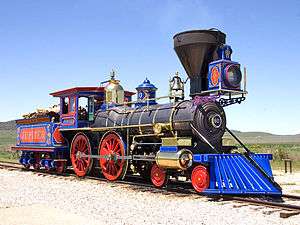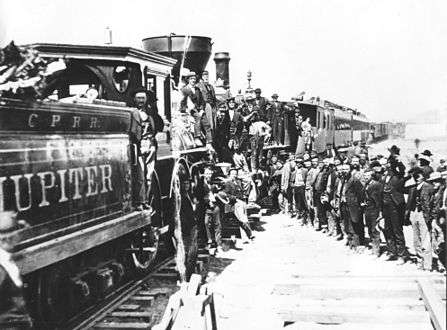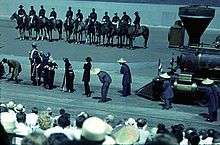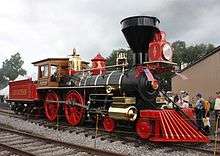Jupiter (locomotive)
The Jupiter (officially known as Central Pacific Railroad #60) was a 4-4-0 steam locomotive owned by the Central Pacific Railroad. It made history when it joined the Union Pacific No. 119 at Promontory Summit, Utah, during the Golden Spike ceremony commemorating the completion of the First Transcontinental Railroad in 1869.
| Jupiter | |||||||||||||
|---|---|---|---|---|---|---|---|---|---|---|---|---|---|
 Jupiter replica at Golden Spike N.H.S. | |||||||||||||
| |||||||||||||
| |||||||||||||
| |||||||||||||
The Jupiter was built in September 1868 by the Schenectady Locomotive Works of New York, along with three other engines, numbered 61, 62, and 63, named the Storm, Whirlwind, and Leviathan, respectively. These were then dismantled and sailed to San Francisco, California, loaded onto a river barge, and sent to the Central Pacific headquarters in Sacramento. After reassembly they were commissioned into service on March 20, 1869.
History


The Jupiter was not Leland Stanford's original choice for transporting his party to the Golden Spike site. Originally, Stanford's train was to be pulled by another Central Pacific locomotive, the Antelope. For some distance, this train followed closely behind a regularly scheduled train pulled by the Jupiter. However, at one point the two trains were to go through a cut where a logging camp resided atop the hill. Apparently, the proper flag to designate an extra following close behind either had not been worn by the Jupiter, or had been unnoticed by the workers, and once the Jupiter passed, the workers rolled a large log down the mountain, which struck the Antelope. With the engine damaged, a message was sent to the upcoming station to hold the approaching train. There, Stanford's consist was added to the Jupiter's train.
Post-ceremony career
After the ceremony, Jupiter continued in service for the Central Pacific. In the 1870s, the railroad decided to end their practice of naming their engines, and thus, the Jupiter name was dropped and the engine was simply known as C.P. #60. The locomotive also received many upgrades, including a new boiler, cowcatcher, domes, and smokestack. In 1891, the Southern Pacific, which acquired the Central Pacific in 1885, began renumbering its locomotives, and C.P. #60 became S.P. #1195. In 1893 it was converted to burn coal, and later that year was sold to the Gila Valley, Globe and Northern Railway and designated GVG&N #1. In 1909, the railway, which had been acquired by the Southern Pacific in 1901, sold the engine for scrap.
Reproductions

The Southern Pacific, by 1901, had been placed under the control of the Union Pacific, the management of which remained largely indifferent towards both the Jupiter and the railroad's own no. 119, acknowledging neither's historical significance until well after being scrapped. For events such as the 1939 New York World's Fair and the Chicago Railroad Fair, the Virginia and Truckee Railroad's cosmetically altered Genoa locomotive stood in for the Jupiter in reenactments of the Golden Spike ceremony.[2]
The 1939 film Union Pacific also featured a recreation of the ceremony, in which the Jupiter was portrayed by Virginia and Truckee Railroad's Inyo. In 1969, in observation of the centennial of the Golden Spike, the Genoa again portrayed the Jupiter, operating on a section of restored trackage at the Golden Spike National Historic Site with the Virginia and Truckee's Reno portraying the Union Pacific no. 119.[3] The same year, the Union Pacific operated a special exhibition train, consisting of the Virginia and Truckee's Inyo and Dayton as proxies, along with vintage railroad construction equipment, all displayed on flatcars, which toured various parts of the Union Pacific network through the year. In 1970, the Reno was sold to Old Tucson Studios, while the Genoa was returned to the state of California, with the Inyo and Dayton replacing them as displays at Promontory.
In 1974, the National Park Service had approached O'Connor Engineering Laboratories of Costa Mesa, California, to construct exact, full-size replicas of the Jupiter and Union Pacific 119. As was the case with the engines themselves, no drawings or plans of the engines survived, necessitating entirely new drawings to be produced based mostly on photos of the engines as well as research done on similar engines built around the same time. That same year, the existing engines portraying the Jupiter and 119 (the Inyo and Dayton, respectively), had been sold to the state of Nevada, though they remained displayed at the Golden Spike NHS until the construction of the new replicas was complete. Noted railroad historian and steam engine owner Gerald M. Best served as engineering consultant to the Park Service for the project. Former Disney animator Ward Kimball was given the task of painting the replicas.[4] The Jupiter was given a bright red paint scheme with gold leafing, typical of locomotives built in the 1870s.[5][6][7]
The replicas were completed in 1979, and began operations on May 10 of that year, 110 years after the original Golden Spike ceremony, and continue to make demonstration runs.[4]
In the early 1990s, a vague description of the Jupiter's livery had been found in a recently uncovered March 1869 issue of The Sacramento Bee, in which the engine was said to be blue, crimson, and gold.[8] The engine was repainted into its current livery based on this finding along with further research on liveries of similar engines of the time. The repainted engine debuted on May 10, 1994, coinciding with the 125th anniversary of the Golden Spike ceremony.
Other historic Jupiter locomotives

Jupiter was known as "King of Gods" or "God of Sky", and it was common for railroads of the 1800s to name engines after this and other mythological legends to invoke awe and wonder. Thus, there have been many engines named "Jupiter" by their respective railroads that, apart from the name, had little else in common with the engine of Golden Spike fame. One such engine is Santa Cruz Railroad no. 3, also named Jupiter.[9] This engine, owned by the Smithsonian Museum, is also a wood-burning 4-4-0. However, this engine was built for narrow-gauge track, unlike the broader standard gauge of the trains at the Golden Spike ceremony.
In 2009, Kloke Locomotive Works built a full-size replica of one of the Jupiter's sibling engines, the Leviathan, no. 63, which is operational.
References
- Builder's plate on replica.
- Appleman, Roy E. (July 1966). Union Pacific Locomotive #119 And Central Pacific Locomotive #60, Jupiter, At Promontory Summit, Utah, May 10, 1869 (PDF). Washington, D.C.: National Park Service – via CPRR.org.
- "Exhibits". California Railroad Museum.
- Broggie, Michael (2006). Walt Disney's Railroad Story: The Small-Scale Fascination that Led to a Full-Scale Kingdom (second ed.). Virginia Beach, Virginia: The Donning Company Publishers. pp. 149–50. ISBN 1-57864-309-0.
- Dowty, Robert R. (1994). Rebirth of the Jupiter and the 119: Building the Replica Locomotives at Golden Spike. Tucson, AZ: Southwest Parks & Monuments Association. p. 35.
- National Park Service, Dept. of the Interior, Golden Spike National Historic Site, Brigham City, UT. "Golden Spike" (PDF). Retrieved August 17, 2011.CS1 maint: multiple names: authors list (link)
- Promontory Locomotive Project: Plans for the Jupiter and No. 119 (DVD)
|format=requires|url=(help). Western National Parks Association. - "Golden Spike's Jupiter may get true blue paint job". Deseret News. Associated Press. January 2, 1994. Retrieved 1 February 2018.
- "The narrow-gauge Jupiter at the Smithsonian". American History. Smithsonian Institution.
- Golden Spike National Historic Site (2006). Everlasting Steam: The Story of Jupiter and No. 119. (PDF). Brigham City, UT: U.S. National Park Service.